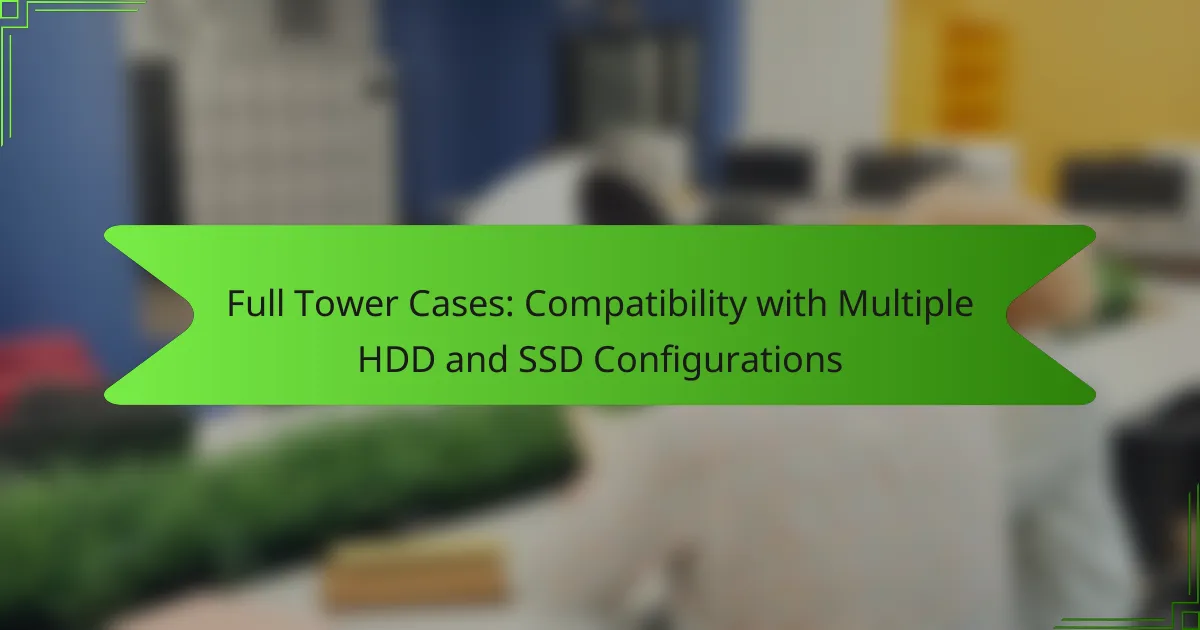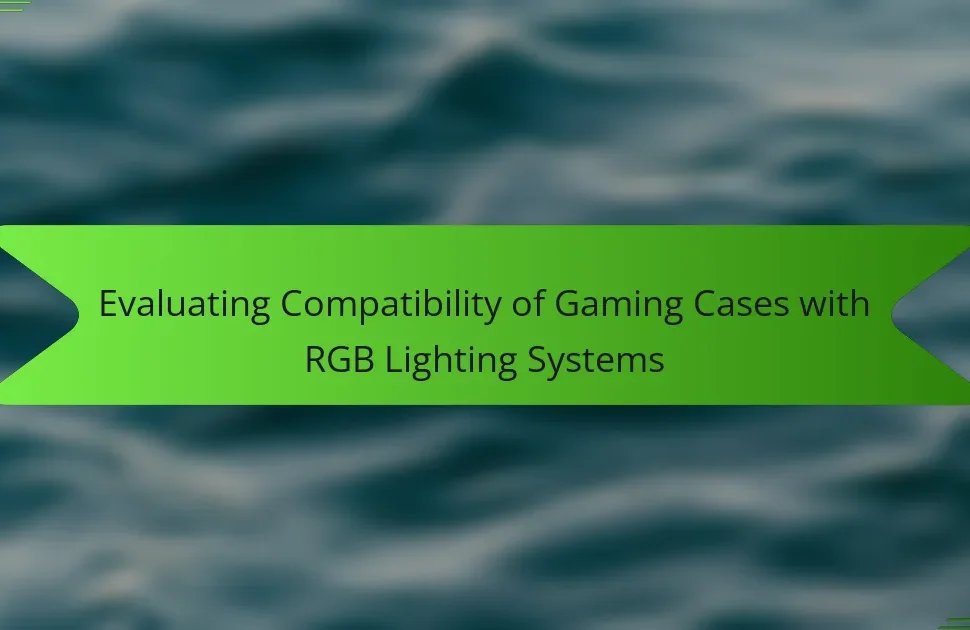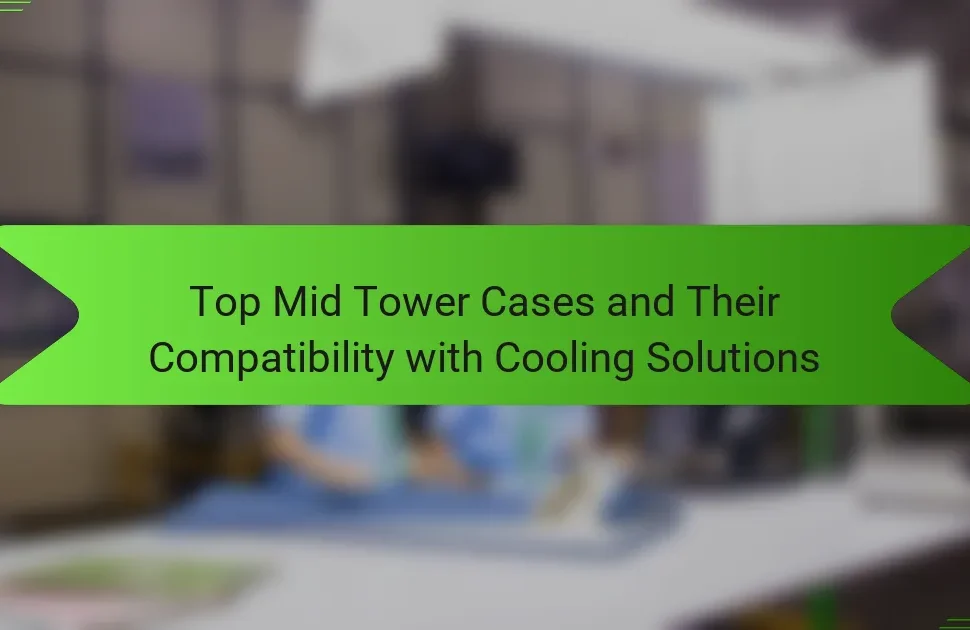
What are Full Tower Cases and their Importance in PC Building?
Full tower cases are large computer chassis designed to accommodate a variety of components. They typically provide more space for multiple hard drives, SSDs, and cooling solutions. This size allows for better airflow and expansion opportunities. Full tower cases often support larger graphics cards and motherboards. They can house advanced cooling systems, including liquid cooling setups. Their design facilitates easier cable management and component accessibility. Additionally, full tower cases are beneficial for future upgrades. They ensure compatibility with high-performance hardware configurations.
How do Full Tower Cases differ from other case types?
Full tower cases differ from other case types primarily in size and expandability. They typically offer more space for components compared to mid-tower or mini-tower cases. This additional space allows for greater airflow and cooling options. Full tower cases can accommodate larger motherboards, such as E-ATX, which are not supported by smaller cases. They also provide more drive bays for multiple HDDs and SSDs, enhancing storage capacity. Furthermore, full tower cases often have more expansion slots for graphics cards and other peripherals. This makes them ideal for high-performance builds. The increased dimensions facilitate better cable management and organization as well.
What are the key dimensions and specifications of Full Tower Cases?
Full tower cases typically have dimensions around 20 to 25 inches in height, 8 to 10 inches in width, and 18 to 24 inches in depth. These cases support large motherboards, including ATX and E-ATX formats. They often provide space for multiple HDDs and SSDs, accommodating up to 10 or more drives. Full tower cases usually feature extensive cooling options, including space for multiple fans and radiators. They also include various ports and connectivity options on the front panel. Many models incorporate cable management features for improved organization. The material used can vary, often including steel, aluminum, or tempered glass. These specifications make full tower cases suitable for high-performance builds.
Why might a builder choose a Full Tower Case over a Mid or Mini Tower?
A builder might choose a Full Tower Case over a Mid or Mini Tower for enhanced compatibility with multiple HDD and SSD configurations. Full Tower Cases typically offer more drive bays than their smaller counterparts. This allows for greater storage capacity and flexibility in configuring drives. Additionally, Full Tower Cases provide improved airflow and cooling options. They can accommodate larger cooling solutions and multiple fans. This is crucial for high-performance builds that generate more heat. The spacious interior also allows for easier cable management. Overall, the design of Full Tower Cases supports extensive customization and future upgrades.
What configurations can be achieved with Full Tower Cases?
Full tower cases can accommodate various configurations for hard disk drives (HDDs) and solid-state drives (SSDs). They typically support multiple drive bays, allowing for extensive storage options. Many full tower cases feature up to 10 or more 3.5-inch HDD bays and several 2.5-inch SSD slots. This flexibility enables users to configure systems with a mix of HDDs for large storage capacity and SSDs for speed. Additionally, full tower cases often provide ample space for advanced cooling solutions, which can be essential for high-performance setups. They also support multiple graphics cards and motherboards, enhancing overall system capabilities.
How many HDD and SSD drives can be accommodated in a Full Tower Case?
A Full Tower Case can typically accommodate 6 to 12 HDD drives and 2 to 6 SSD drives. The exact number depends on the specific model and design of the case. Many Full Tower Cases feature dedicated bays for both HDDs and SSDs. For instance, a common configuration includes 8 HDD bays and 4 SSD slots. This flexibility allows for extensive storage options. Full Tower Cases are designed to support large motherboards and additional components, enhancing their capacity for drives.
What is the significance of drive bays and mounting options in these cases?
Drive bays and mounting options are crucial in full tower cases for accommodating multiple HDDs and SSDs. They determine the maximum storage capacity that can be integrated into the system. Adequate drive bays allow for easier installation and organization of drives. Proper mounting options ensure drives are securely held in place, preventing damage during operation. Additionally, good airflow around the drives is facilitated by thoughtful layout designs. This airflow helps maintain optimal temperatures, which is vital for the longevity of storage devices. Overall, the significance lies in enhancing storage flexibility, ease of use, and system performance.
What factors influence compatibility with HDD and SSD in Full Tower Cases?
Compatibility with HDD and SSD in Full Tower Cases is influenced by several factors. First, the number of drive bays available determines how many drives can be installed. Full tower cases typically offer multiple 3.5-inch bays for HDDs and 2.5-inch bays for SSDs. Second, the physical dimensions of the drives must match the specifications of the bays. HDDs and SSDs have different sizes, which affects their placement. Third, cooling solutions impact compatibility. Adequate airflow is necessary to prevent overheating of both types of drives. Fourth, power supply capacity is crucial. It must provide sufficient wattage for multiple drives. Lastly, motherboard compatibility is essential. The motherboard must support the necessary connections for both HDDs and SSDs. These factors collectively determine how well HDDs and SSDs can coexist in a full tower case.
How does the design of Full Tower Cases affect drive installation?
Full tower cases facilitate easier drive installation due to their spacious interior. The larger size allows for more drive bays, accommodating multiple HDDs and SSDs. This design often includes tool-less drive mounting systems, simplifying the installation process. Additionally, ample cable management space helps in organizing and connecting drives efficiently. Full tower cases typically support various drive sizes, including 3.5-inch and 2.5-inch drives. Enhanced airflow in these cases prevents overheating during operation. Overall, the design of full tower cases significantly streamlines the installation of multiple drives.
What are the common sizes and formats of HDDs and SSDs compatible with Full Tower Cases?
Common sizes and formats of HDDs and SSDs compatible with Full Tower Cases include 3.5-inch HDDs and 2.5-inch SSDs. Full Tower Cases typically support multiple drive bays for these sizes. Most Full Tower Cases can accommodate up to six or more 3.5-inch drives. They also often include additional bays for 2.5-inch SSDs. Some cases may provide flexibility for mounting both types in various configurations. This compatibility allows for extensive storage solutions. Full Tower Cases are designed to handle larger components, ensuring ample space for drives.

How do Full Tower Cases support cooling and airflow for multiple drives?
Full tower cases support cooling and airflow for multiple drives through their spacious design and advanced airflow features. They typically offer multiple fan mounting locations, allowing for optimal airflow direction. This design enables efficient heat dissipation from hard drives and solid-state drives. Additionally, full tower cases often include mesh panels that enhance air intake and exhaust. The larger volume of these cases facilitates better circulation of cool air. Many designs also support liquid cooling solutions, which further improves thermal management. The combination of these elements ensures that multiple drives remain at safe operating temperatures. Enhanced airflow contributes to overall system stability and performance.
What cooling solutions are available for Full Tower Cases with multiple drives?
Full tower cases with multiple drives can utilize various cooling solutions. Air cooling is commonly achieved through multiple fans strategically placed for optimal airflow. Liquid cooling systems, including all-in-one (AIO) coolers, can also be integrated for efficient heat dissipation. Additionally, custom water cooling loops provide enhanced cooling performance and aesthetics. Some full tower cases feature dedicated cooling zones to manage heat from multiple drives effectively. Furthermore, utilizing drive bays with built-in cooling fans can help maintain lower temperatures. Proper cable management and airflow design are essential for maximizing cooling efficiency. These solutions ensure that full tower cases remain cool even under heavy loads, supporting high-performance components.
How does airflow impact the performance and longevity of HDDs and SSDs?
Airflow significantly impacts the performance and longevity of HDDs and SSDs. Proper airflow helps maintain optimal operating temperatures for both types of drives. High temperatures can lead to thermal throttling in SSDs, reducing speed and efficiency. For HDDs, excessive heat can accelerate mechanical wear and increase the risk of failure.
Research shows that HDDs typically operate best below 60°C, while SSDs can tolerate slightly higher temperatures, around 70°C. Inadequate airflow can result in heat buildup, which may shorten the lifespan of these drives. Effective cooling solutions, such as fans and ventilation, are essential in full tower cases to ensure consistent airflow.
Maintaining appropriate airflow not only enhances performance but also extends the overall lifespan of HDDs and SSDs.
What are the best practices for cable management in Full Tower Cases?
The best practices for cable management in Full Tower Cases include using cable ties to secure cables. This prevents tangling and improves airflow. Additionally, routing cables behind the motherboard tray minimizes visible clutter. Utilizing Velcro straps or adhesive clips can help keep cables organized. It is essential to plan cable paths before installation for optimal layout. Keeping power supply cables separate from data cables reduces interference. Regularly checking and adjusting cable management maintains a tidy setup. These practices enhance aesthetics and cooling efficiency in full tower cases.
What are the aesthetic considerations when configuring drives in Full Tower Cases?
Aesthetic considerations when configuring drives in Full Tower Cases include visual harmony and organization. The arrangement of drives should complement the overall design of the case. Utilizing color-coordinated drives can enhance the visual appeal. Cable management also plays a crucial role in maintaining a clean look. Properly routed cables prevent clutter and improve airflow. Transparent side panels can showcase the drive configuration, making aesthetics even more important. Lighting effects can further enhance the visual impact of the drives. Overall, thoughtful configuration can significantly improve the aesthetics of a Full Tower Case.
How can lighting and drive placement enhance the visual appeal of a build?
Lighting and drive placement can significantly enhance the visual appeal of a build. Strategic lighting highlights key components and creates an inviting atmosphere. For instance, RGB lighting can be synchronized with system performance, adding dynamic visual interest. Proper drive placement ensures that cables remain organized and out of sight. This organization contributes to a clean and professional look. Additionally, showcasing drives through transparent panels can create a modern aesthetic. The arrangement of drives can also influence airflow, which indirectly affects the overall appearance by preventing clutter. A well-lit and organized build is visually striking and showcases the builder’s attention to detail.
What role do transparent side panels play in showcasing multiple drives?
Transparent side panels in full tower cases allow users to visually showcase multiple drives. This design element enhances aesthetics by displaying the drives’ arrangement and lighting. Users can easily monitor the status of drives, such as activity indicators. Additionally, transparent panels facilitate airflow visibility, ensuring optimal cooling for components. The visibility can also highlight customizations, such as RGB lighting on drives. This feature appeals to gamers and PC builders who value both functionality and design. Transparent panels thus serve both practical and aesthetic purposes in showcasing drive configurations.

What are the challenges and troubleshooting tips for Full Tower Cases?
Full tower cases present challenges such as size limitations and airflow management. These cases can accommodate multiple HDD and SSD configurations but require careful planning. Users may struggle with cable management due to the spacious interior. Additionally, weight distribution can be an issue when fully loaded with components.
To troubleshoot, ensure all components are compatible with the case specifications. Utilize cable ties for better organization of cables. Check for adequate airflow by positioning fans correctly. Regularly clean dust filters to maintain optimal cooling. Ensure that all screws and components are securely fastened to avoid vibrations.
What common issues arise when configuring multiple HDDs and SSDs?
Common issues when configuring multiple HDDs and SSDs include compatibility, performance imbalance, and power supply limitations. Compatibility issues arise when the motherboard does not support the required number of drives or specific interfaces. Performance imbalance occurs because SSDs are significantly faster than HDDs, which can lead to bottlenecks in data transfer. Power supply limitations may arise if the PSU cannot provide enough wattage for all drives. Additionally, thermal management becomes challenging as multiple drives generate heat, potentially affecting system stability. Lastly, improper RAID configurations can lead to data loss or reduced performance.
How can users troubleshoot compatibility issues in Full Tower Cases?
To troubleshoot compatibility issues in Full Tower Cases, users should first check the motherboard dimensions. Full tower cases support standard ATX, E-ATX, and other form factors. Next, users must verify GPU clearance. Measure the length of the graphics card against the case specifications. Additionally, users should confirm CPU cooler height. Many full tower cases have ample space, but specific limits exist.
Users should also assess drive bay configurations. Ensure that HDD and SSD sizes fit within the allocated slots. Check power supply compatibility as well. The wattage and physical dimensions need to align with case requirements. Lastly, users should consult the case manual for detailed compatibility information. This manual typically includes diagrams and specifications to assist in the setup process.
What maintenance tips can help ensure optimal performance of installed drives?
Regularly monitoring drive temperatures ensures optimal performance of installed drives. High temperatures can lead to hardware failure and data loss. Use software tools to check temperatures and ensure they remain within manufacturer specifications. Keeping drives clean from dust improves airflow and cooling efficiency. Schedule regular cleaning every few months to maintain optimal conditions. Defragmenting traditional HDDs enhances performance by organizing fragmented data. Regularly checking for firmware updates can provide performance improvements and security fixes. Additionally, backing up data frequently protects against data loss due to drive failure. Implementing these maintenance tips can significantly extend the lifespan and performance of installed drives.
What are the best practices for selecting and installing drives in Full Tower Cases?
Select drives compatible with the motherboard and power supply. Ensure the drives fit within the case’s drive bays. Use SSDs for faster performance and HDDs for larger storage capacity. Consider cooling options to prevent overheating during operation. Secure drives with screws or mounting brackets to avoid vibrations. Cable management is essential for airflow and accessibility. Regularly check connections to maintain optimal performance. Follow manufacturer guidelines for installation to ensure reliability.
How should users prioritize storage needs when choosing HDDs and SSDs?
Users should prioritize storage needs by assessing performance, capacity, and budget when choosing HDDs and SSDs. HDDs offer larger storage capacities at lower prices, making them suitable for bulk data storage. SSDs provide faster data access and improved performance, ideal for operating systems and applications. Users should consider their usage patterns; SSDs are preferable for speed-sensitive tasks. For large media files or backups, HDDs are more cost-effective. A balance between both can optimize storage solutions. According to a study by TechSpot, SSDs can be up to 100 times faster than HDDs in read/write speeds. Therefore, understanding these factors helps users make informed decisions.
What tools and techniques are essential for a successful installation?
Essential tools for a successful installation include a screwdriver set, anti-static wrist strap, and cable ties. A screwdriver set is crucial for securing components. An anti-static wrist strap prevents electrostatic discharge, protecting sensitive parts. Cable ties help manage and organize cables, ensuring a neat setup. Techniques for installation involve carefully planning the layout. This includes determining the optimal placement of HDDs and SSDs. Following the manufacturer’s guidelines ensures compatibility and functionality. Additionally, testing each component before final assembly verifies proper operation.
Full tower cases are large computer chassis designed to accommodate multiple HDD and SSD configurations, offering significant advantages in terms of storage capacity, airflow, and cooling options. This article explores the dimensions, specifications, and compatibility factors of full tower cases, highlighting their ability to support advanced hardware setups. Key topics include the installation process, cable management best practices, and the impact of airflow on drive performance and longevity. Additionally, the article addresses common challenges and troubleshooting tips for optimizing the use of HDDs and SSDs in full tower cases. Overall, it provides a comprehensive overview of the benefits and considerations for builders choosing full tower cases for their PC configurations.




